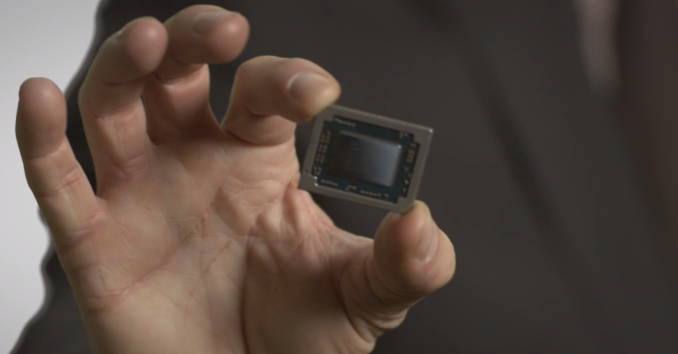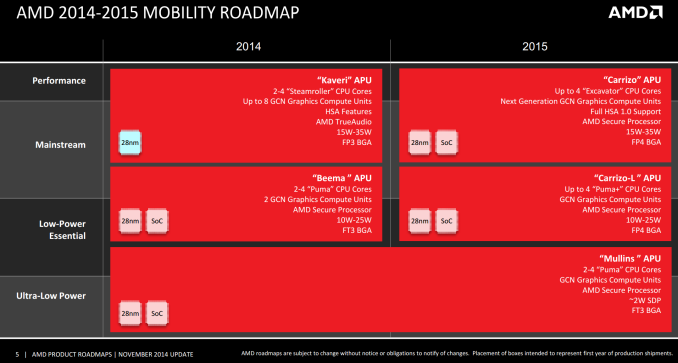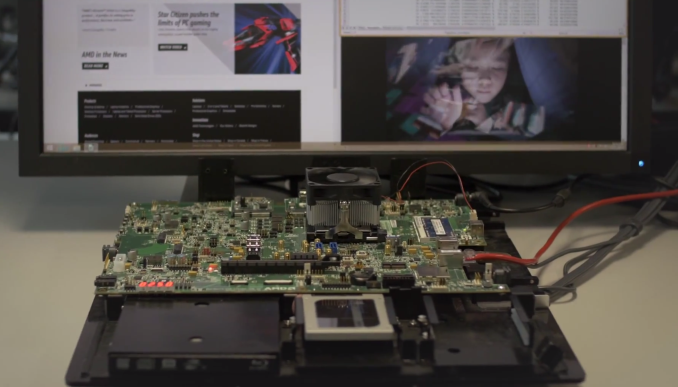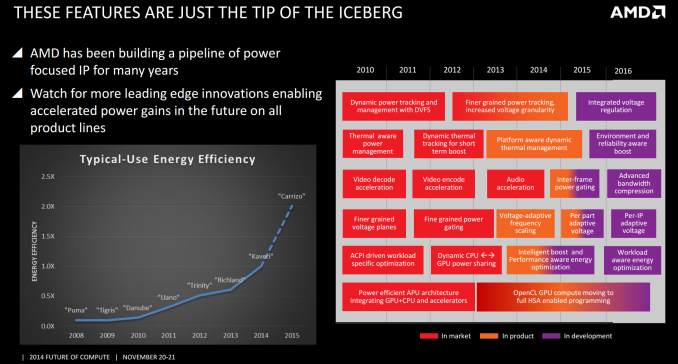AMD’s Carrizo not on the Desktop? Depends What You Define as Desktop
by Ian Cutress on January 13, 2015 5:20 AM EST
We reported on AMD’s next iteration of their Bulldozer architecture, code named Excavator, during the press release regarding their next processor line up called Carrizo. At the time, the focus for Carrizo (and Carrizo-L) was aimed at notebooks and laptops, with the road-map from AMD on 2015 looking at 15-35W BGA parts in the performance and mainstream. Carrizo-L specifically took Puma+ cores, from the Cat family of cores, down to 10-25W, with Mullins running the ultra-low-power market at 2W. All of these being full SoCs, and soldered down BGA packages. The feeling at the time was that Carrizo would be a mobile focused launch, with the potential for desktop to be examined at a later date as AMD takes pride in owning the desktop integrated graphics title with Kaveri, and AMD would need something to compete against the upcoming Broadwell as well as Skylake in 2015.
However, in our periphery we noted The Tech Report come out and categorically state that ‘Carrizo will face off with Broadwell-U, won’t land in desktops’. The first part of that is definitely true, with Carrizo’s 15W-35W range synchronizing nicely with Broadwell-U’s 15W-28W parts, however the second part of it is somewhat new. Up until this point, AMD had neither confirmed nor denied (in true CIA style) about the future of their desktop landscape, to the point that their desktop roadmap stopped at 2014:
The Tech Report mentions a single line to the claim: ‘AMD has no plans to offer Carrizo as a socketed chip for desktop PCs’. We reached out to AMD for some form of confirmation or explanation as to this line, because it felt kind of odd. With a well-positioned launch, with enough SKUs in enough markets to cater up and down the price range, AMD could re-launch the APU line with the latest architecture updates for the better. We received the following response from AMD’s James Prior:
“With regards to your specific question, we expect Carrizo will be seen in BGA form factor desktops designs from our OEM partners. The Carrizo project was focused on thermally constrained form factors, which is where you'll see the big differences in performance and other experiences that consumers value.”
There’s no direct denial of socketed Carrizo based parts here, but all arrows point to BGA desktops, such as all-in-ones and mini-PCs (the high-end segment for Broadwell-U). We have seen at least one socketed part, when AMD launched its Carrizo video:
But this was labelled as a pure engineering sample when we saw it at AMD’s suite at CES. So while we can’t confirm the ‘no plans’ part from TR’s quote, Carrizo as a socketed part for desktops is currently not public knowledge as of yet. AMD is in a quiet period right now and not wanting to rock the boat from what is currently on the market by announcing anything on the desktop side. This is despite AMD’s list of features being a prominent slide in their Carrizo slide deck, most of which would be important parts within a desktop environment.
If AMD is planning no further socketed desktop APUs from the base-Bulldozer architecture, we would have to head towards Jim Keller's team and K12/Zen in 2016 as the next port of call, despite that platform currently being touted more for low power, servers and embedded right now. Part of me wants to believe we won’t have to wait that long, given that Kaveri first appeared in January 2014 at it would mark a two-to-three year gap on the desktop side. Even AMD would have a hard time explaining that one, unless it made financial sense overall.














34 Comments
View All Comments
medi03 - Tuesday, January 13, 2015 - link
Such as... consoles... cough... ;)yannigr2 - Tuesday, January 13, 2015 - link
AMD is doing to FM2+ what they did to AM3+. AM3+ will go one more year without new models. FM2+ will have a year similar to 2014 for AM3+. A few extra models with the Kaveri architecture like the 7650K they just announced and to be honest it is extremely interesting.I bet they hope that Mantle and later DX12 will offer a little more value to their CPUs and APUs, so they believe they don't really need to update the hardware, just wait for the software to catch up. Looking at the benchmarks for Shadow of Mordor at Tom's hardware where AMD hardware is on top in GPU benchmarks(strange for Tom's benchmarks), and even 4170 is very competitive with 5930, I would say that they probably feel that the hardware they offer at the prices they are selling it today, is good enough for one more year.
But after saying all that, it does look that AMD does have a problem to convince their partners to expand the socketed platforms with new models that will need more work from motherboard makers on the BIOS side.
Anyone can give an idea how much more difficult it is for a motherboard manufacturer to create a new hardware to support excavator cores, compared to a new BIOS to just support new Kaveri models? that could answer very important questions about AM3+ and FM2+ stall.
yannigr2 - Tuesday, January 13, 2015 - link
last paragraph correctionAnyone can give an idea how much more difficult it is for a motherboard manufacturer to create a new BIOS to support excavator cores, compared to a new BIOS to just support new Kaveri models? that could answer very important questions about AM3+ and FM2+ stall.
Nil Einne - Wednesday, February 11, 2015 - link
Well I don't think it's clear that AM3+ even has a future (or any non iGPU desktop). FM2+ we hope does, although it's possible DDR4 will be the norm by the 2016 and they won't bother with including a DDR3 memory controller. Particularly if they have other reasons to abandon FM2+. And the very least, we hope that AMD doesn't abandon the socket market entirelyEndgame124 - Tuesday, January 13, 2015 - link
Am I the only one who still wants a 125 Watt cpu? I was really hoping for 125W Carrizo high end part between $125 - $150. My trinity system (watercooled with a d5 and 2 of my old HWLabs 120x2 rads) is my "do everything" machine for surfing, e-mail, Eve online clients, etc, but I was really looking forward to an upgrade with a faster integrated GPU.As a desktop machine, I don't need power efficiency (no battery), and I don't need low heat (plenty of room for cooling). Why does the market insist on leaving that niche behind?
robi - Tuesday, January 13, 2015 - link
You're not the only one. I will be bitterly disappointed if Carrizo doesn't get launched for socketed desktops.mcirillo - Tuesday, January 20, 2015 - link
ditto.Nil Einne - Wednesday, February 11, 2015 - link
Because the niche is way too small by now. It's only a small number of enthuasists and little else.Nil Einne - Wednesday, February 11, 2015 - link
Sorry I meant to clarify, the niche of not caring about power effiency or heat at all. Remembering in particular that water cooling is still only a tiny percentage of the market. So the truth is very few people are willing to put up with that level TDP, unless they're getting what they consider an acceptably powerful system in return (regardless of whether they use it), and sadly only Intel can match that at the moment. AMD may not be having that much success by keeping TDP down at the expense of performance, but it's surely better than the alternative. Remembering as well that most overclocking and different TDP comparisons suggests the actually gain from AMD TDP increases tends to be small (not surprising since the CPU and process is increasingly optimised for lower power and as others have said and somewhat indicated in my post, only Intel can afford to concentrate any effort on real optimising their higher TDP CPUs).DrApop - Tuesday, January 13, 2015 - link
I don't understand why AMD hasn't entered into the chromeOS arena. With their graphics, I would think they would do well in a chromebox.....not so much the laptop but certain the celeron chromeboxes from Asus and HP.